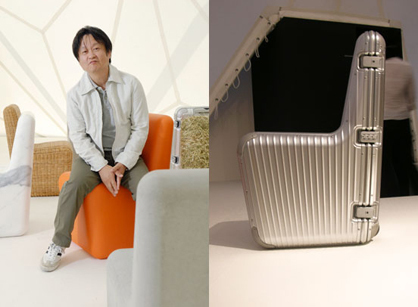Mingei
Text by Miyuki Tanaka
London, United Kingdom
21.01.08
"Limited edition" obscures the boundary of design and art. Craft elements bring singularity into mass-produced works and lift them to an art piece.
Design in a “limited edition” obscures the boundary of design and art. Craft elements bring an element of uniqueness to otherwise mass-produced works and raise them to an art object on the market. Editions set designers free from all the restrictions and constraints facing their regular works, and have the potential to broaden the idea of design by encouraging experiments. At the same time we cannot stop asking ourselves: does design want to be an art after all? Does “limited edition” not contradict the idea of design in the first place? For some it must have been intriguing to see works of designers like Naoto Fukasawa and Jasper Morrison in the Vitra Edition 2007. They usually seem to share the idea that design should be unobtrusive and discrete, as seen in the “Super Normal” exhibition where they exhibited “super normal” objects like paper clips and ashtrays.
Naoto Fukasawa and his Chair series for Vitra Edition
The way they promote appreciation of everyday objects even recalled the Japanese art and craft movement of the 1920s. The movement, called “MINGEI (literally means arts for everyone),” was led by Soetsu Yanagi (father of Sori Yanagi) and ignited an academic debate about appreciating beauty in everyday objects. As there wasn’t an idea of design at that time, he saw craft as a way to personify objects to improve the quality of life for everybody in the cold, mechanized society. However, his strong passion for craft ironically led to individually-produced, elaborate, even signed pottery and textiles. Those works were born out of respect for everyday life and turned out to be “high” art, which was only accessible to a limited number of collectors. We learned then that the involvement of craft sets another obstacle to keeping a balance between function and aesthetics. And as consumers are now seeking variety and rarity, decoration and simplicity, function and ornament at the same time, will the idea of design in its next stage contain both elitism and populism?
Nihon Mingeikan (The Japan Folk Craft Museum) is founded by Soetsu Yanagi in 1936 and located in Tokyo. With its beautiful traditional building, it is the best place to see the collections of the Mingei Movement.
Soetsu Yanagi, ceramics by Bernard Leach and Shoji Hamada
Precious bulk commodity with hand crafted aesthetics: Shippo plates by Hella Jongerius for Cibone, 2007

Precious bulk commodity with hand crafted aesthetics: Shippo plates by Hella Jongerius for Cibone, 2007
×





